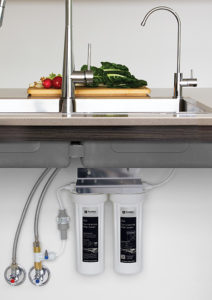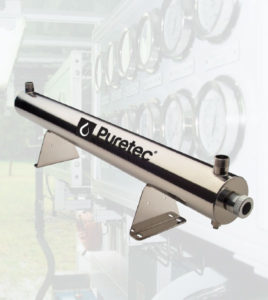Water Filters
There are many different types of water filters, usually you have two types of installations.
Point of Use: This means a filter for each point of use, either kitchen sinks, filtered taps, appliances, hot water systems etc – Unfiltered water enters the house, runs through the pipework and only becomes filtered before being used.
Point of Entry: This means a filter as water enters the property, for instance this would be a whole house filter protecting your entire house from poor water, thus extending the life of your appliances (Fridge, hot water unit, kettles, coffee machines) and fixtures (Taps, Toilets, Basins etc) – It will also prevent calcium build up on your shower screen!
Different type of Filtration
- Single stage system: This may be a cartridge or disposable type filter, with either a carbon filter.
- Two stage system: This is usually a carbon filter and ceramic filter combination - to take the taste, odor and smell of incoming water, and also filter out Iron, Chlorine, Calcium and other organic material.
- Three stage system+ : This is the same as a two stage with extra cartridges, such as activated aluminum or others.
- Reverse Osmosis system: This is a very powerful type of water filtration which uses the osmosis process through a membrane to provide close to pure water. This is used usually for more commercial style filtration systems and is overkill for drinking water.
- UV filtration: This type of filtration is usually used for storage rain water or water purification systems where the water quality is unknown and not stable. Passing water through a UV filter kills over 90% of bacteria and provides a non chemical option for purified water.
- Water Ionizers/Infra Red Filters: Fairly new to the domestic water market. Used successfully in filtering pools.

Puretec Under Sink Two Stage Water filter with stand alone tap.
Under Sink Water Filters
Under sink water filters are a great and popular way of providing Point of Use filtration to where you would use it the most. A twin cartridge system is usually installed under the kitchen sink, close to the incoming water supply and a filter tap is installed on the bench top / sink. You can also get a few different type of under bench systems that come with a three way tap, which means you can use cold /hot water and also get filtered water from the same spout – meaning you don’t need to drill a new hole in the sink or bench top. The whole installation usually takes about an hour and usually requires the water to be turned off for thirty minutes or so. You can also add extra filters onto this type of system if you need them.
Under sink Reverse Osmosis systems are also quite popular, they are usually much bigger then a single or two stage under sink system, usually takes about one to two hours to install and is heavily dependent on the space in your kitchen cabinets. It also requires a drain line from the system, as RO water produces a lot of waste water that must be drained into your kitchen sink drain. For every liter of RO water you produce around three to four liters of waste water, so as far as efficient water filters and waste goes, it isn’t particularly efficient, it can take a long time to fill up large containers of water. If you require large quantities of water, its always best to install a pressure vessel along with the RO system, to ensure you have twenty or so litres of RO water ready to go. The pressure vessel works by having a bladder inside the tank, so RO water can be stored under pressure until its required, and replenished after use.
Commercial Water Filters

Puretec UV Domestic/Commercial Filter.
Commercial premises may require different types of filtration for different machines, processes or manufacturing. Usually, bakeries and food prep / restaurants will require Reverse osmosis water for their Combi Steamers / Ovens, Baking appliances, Ice Machines and sometimes Dishwashers – Depending on the manufactures instructions and recommendations, however using RO water will ensure the longevity of the appliances. Ice Machines are usually installed with the minimum of a two stage filter (Carbon and Media) to ensure Ice tastes nice and there is no impurities in the ice itself.
Some premises may choose to install water softeners, this removes calcium (lime scale), iron, organic content and adjusts the PH level (Depending on unit), this protects the entire plumbing system if installed as point of entry – which makes everything last longer, tap washers, taps, appliances, everything! Water softeners work by passing water through a mineral tank which is filled with small polystyrene beads, also know as resin or zeolite, the beads carry a negative charge. Calcium and magnesium in water both carry positive charges. This means that these minerals will cling to the beads as the hard water passes through the mineral tank. Sodium ions also have positive charges, albeit not as strong as the charge on the calcium and magnesium. When a very strong brine solution is flushed through a tank that has beads already saturated with calcium and magnesium, the sheer volume of the sodium ions is enough to drive the calcium and magnesium ions off the beads. Water softeners have a separate brine tank that uses common salt to create this brine solution.
Water Filters Maintenance:
All water filters need scheduled maintenance, as water continually passes through the filter it begins to clog up and stop working. If you notice a reduction in pressure, or water starting to taste off it is time to change your filters. Water filters should be changed every 6 to 12 months depending on water quality. RO filters need to be sanitised and flushed to manufactures recommendations – usually every two years depending on usage. Water softeners need to be serviced to ensure the media stays negatively charged and fresh, so it can do its job at attracting positively charged water impurities and continue softening the water.
PRICING
| Description | Price |
|---|---|
| Multiple water filter available | From $280 |
